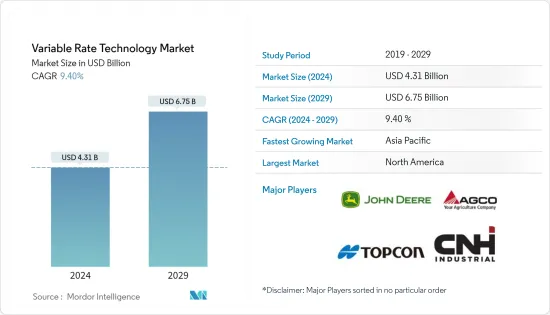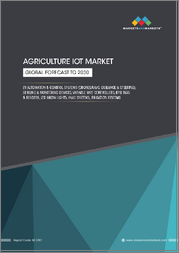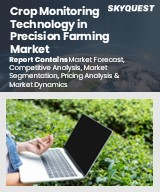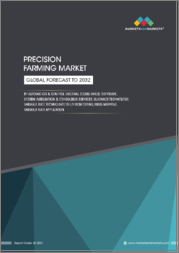
|
시장보고서
상품코드
1434286
세계 변량 살포 기술 시장 : 점유율 분석, 산업 동향 및 통계, 성장 예측(2024-2029년)Variable Rate Technology - Market Share Analysis, Industry Trends & Statistics, Growth Forecasts (2024 - 2029) |
||||||
변량 살포 기술 시장 규모는 2024년 43억 1,000만 달러로 추정되며, 2029년까지 67억 5,000만 달러에 이를 것으로 예측되며, 예측 기간(2024-2029) 동안 9.40%의 연평균 복합 성장률(CAGR)로 성장할 전망입니다.

현재 업계 시장 역학을 보면 미국 등 선진국에서도 변량 살포 기술의 채용은 여전히 매우 낮습니다. 세계 농학자들의 진행 중인 연구는 변동 기술이 작물 수율에 긍정적인 영향을 미치게 되어 비용 절감, 수율 증가, 투입 효율 향상에 도움이 된다는 것을 밝혀냈습니다. 그러므로 변량 살포 기술의 채택으로 인한 경제적 이점에 대한 인식 증가는 예측 기간 동안 시장을 견인할 수 있습니다.
변량 살포 기술 시장 동향
농업 분야에서 디지털 기술 채택 증가
혁신과 기술은 다양한 분야에서 큰 발전을 가져오고 있으며, 농업도 그 중 하나입니다. 센싱 기술, 소프트웨어 용도, 통신 시스템, 데이터 분석 솔루션, 포지셔닝 기술 등은 정밀 농업에 사용되는 최신 기술의 일부입니다. 무인 기계, 자동 착유 시스템, 드론 작물 살포기 등 다양한 기술이 정밀 농업 성장에 중요하고 매력적인 기회를 제공합니다. 2019년 9월 유엔 무역개발 회의가 언급한 바와 같이, 농업에서의 디지털 기술의 도입 상황은 수년에 걸쳐 상당한 증가를 보이고 있습니다. 예를 들어 2019년에는 자동 섹션 제어, 가변 속도 기술, 고정밀 지도, 수율 모니터링, 위성 또는 항공 이미징, 엽록소 센서가 40%, 31%, 48%, 44%, 22%, 5%의 점유율 획득했습니다. 각각 농업 분야에서. 그러므로 농업 분야에서 디지털 기술의 채용이 증가함에 따라 예측 기간 동안 변동 금리 기술 시장의 성장이 가속될 것으로 예상됩니다.
북미가 변량 살포 기술 시장을 견인
수년간 디지털 기술의 채용이 늘어남에 따라 최소한의 비용으로 방대한 양의 중요한 데이터를 수집할 수 있게 되어 현장 작업이 보다 통찰에 근거하여 생산성과 효율성이 향상될 수 있습니다. 최근까지, 변동률 치료 용도의 영향은 사용하는 데이터의 입도와 적시성, 그리고 일상적인 운영상의 의사결정 지원의 부족에 의해 제한되어 왔습니다. 그러나 농무부에 따르면 미국의 농산물 판매자의 60% 이상이 어떤 변동 요금 기술 서비스를 제공하고 있다고 합니다. 이와는 대조적으로 정확한 현장 데이터 수집에는 상대적으로 높은 비용이 들기 때문에 현재 기술을 사용하여 관리되는 면적은 20% 미만입니다. 그러므로 미국 시장에서 변동 요금 치료 용도 서비스의 가용성이 증가함에 따라 예측 기간 동안 변동 요금 기술 시장이 가속화될 수 있습니다.
변량 살포 기술 업계 개요
세계의 변량 살포 기술 시장은 틈새 시장이며, 다양한 중소기업이 세계에서 매우 작은 점유율을 구축하고 있습니다. 그 결과 매우 치열한 경쟁이 발생했습니다. 세계 각지에서 지역 시장과 현지 기업의 발전이 시장 세분화의 주요 요인입니다. 북미와 아시아태평양은 경쟁사의 활동이 가장 활발한 두 지역입니다.
기타 혜택
- 엑셀 형식 시장 예측(ME) 시트
- 3개월의 애널리스트 서포트
목차
제1장 서론
- 조사의 성과
- 조사의 전제
- 조사 범위
제2장 조사 방법
제3장 주요 요약
제4장 시장 역학
- 시장 개요
- 시장 성장 촉진요인과 시장 성장 억제요인의 소개
- 시장 성장 촉진요인
- 시장 성장 억제요인
- 업계의 매력도 - Porter's Five Forces 분석
- 신규 참가업체의 위협
- 구매자/소비자의 협상력
- 공급기업의 협상력
- 대체품의 위협
- 경쟁 기업간 경쟁 관계의 강도
제5장 시장 세분화
- 작물 유형
- 곡물 및 곡류
- 과일 및 야채
- 지방종자 및 콩류
- 상업 작물
- 용도
- 비료
- 농약
- 토양 센싱
- 수율 모니터링
- 관개
- 기타
- 지역
- 북미
- 미국
- 캐나다
- 멕시코
- 기타 북미
- 유럽
- 독일
- 영국
- 프랑스
- 이탈리아
- 스페인
- 기타 유럽
- 아시아태평양
- 중국
- 일본
- 인도
- 한국
- 기타 아시아태평양
- 남미
- 브라질
- 아르헨티나
- 기타 남미
- 중동 및 아프리카
- 남아프리카
- 기타 중동 및 아프리카
- 북미
제6장 경쟁 구도
- 시장 점유율 분석
- 가장 채용된 전략
- 기업 프로파일
- Deere & Company
- Trimble, Inc.
- AGCO Corporation
- Topcon Corporation
- CNH Industrial NV
- Lindsay Corporation
- Ageagle Aerial Systems
- Raven Industries, Inc.
- AG Leader Technology
- Valmont Industries, Inc.
제7장 시장 기회와 앞으로의 동향
JHS 24.03.05The Variable Rate Technology Market size is estimated at USD 4.31 billion in 2024, and is expected to reach USD 6.75 billion by 2029, growing at a CAGR of 9.40% during the forecast period (2024-2029).

Referring to the current market dynamics of the industry, the adoption of variable rate technology is still very low even in the developed nations such as the United States. The ongoing studies by the agronomists across the world reveal that variable rate technology can have a positive impact on the crop yield, thereby aiding in the cost reduction, yield enhancement, and enhancement ofinput efficiency. Thus, the increasing awareness of the economic advantages of variable rate application adoption is likely driving the market during the forecast period.
Variable Rate Technology Market Trends
Increasing Adoption of Digital Technologies in the Agricultural Sector
Innovation and technology have led to major developments in various areas and agriculture is one of them. Sensing technologies, software applications, communication systems, data analytics solutions, and positioning technologies are some of the latest technologies used in precision farming. Various technologies, such as driverless machinery, automated milking systems, and drone crop dusters are providing important and attractive opportunities for the growth of precision agriculture. As stated by the United Nations Conference on Trade and Development in September 2019, over the years the adoption status of digital technologies in agriculture has shown a significant rise. For instance, in 2019, automatic section control, variable rate technology, precision maps, yield monitoring, satellite or aerial imaging, and chlorophyll sensors garnered the shares of 40%, 31%, 48%, 44%, 22%, and 5% respectively in the agricultural sector. Thus, the increasing adoption of digital technologies in the agricultural sector is anticipated to accelerate the growth of the variable rate technology market during the forecast period.
North America to Drive the Variable Rate Technology Market
Over the years, the increasing adoption of digital technologies has made it possible to collect huge amounts of critical data at minimal costs, thus making field operations more insight-driven, and potentially more productive and efficient. Until recently, the impact of variable rate treatment application has been limited by the granularity and timeliness of the data they use and their lack of day-to-day operational decision support. However, according to USDA, over 60% of the United States' agricultural input dealers offer some kind of variable-rate technology services. Contrasting to this, less than 20% of the acreage is currently being managed using technology due to the relatively higher costs of gathering precise field data. Thus, the rising availability of the variable rate treatment application services in the United States market is likely to accelerate the variable rate technology market during the forecast period.
Variable Rate Technology Industry Overview
The global variable rate technology market is a niche market, with various small and medium-sized companies coining a very minimal share in the world. This has resulted in very stiff competition. The development of regional markets and local players in different parts of the world is the major factor for the fragmented nature of the market. North America and the Asia Pacific are the two regions showing maximum competitor activities.
Additional Benefits:
- The market estimate (ME) sheet in Excel format
- 3 months of analyst support
TABLE OF CONTENTS
1 INTRODUCTION
- 1.1 Study Deliverables
- 1.2 Study Assumptions
- 1.3 Scope of the Study
2 RESEARCH METHODOLOGY
3 EXECUTIVE SUMMARY
4 MARKET DYNAMICS
- 4.1 Market Overview
- 4.2 Introduction to Market Drivers and Restraints
- 4.3 Market Drivers
- 4.4 Market Restraints
- 4.5 Industry Attractiveness - Porter's Five Force Analysis
- 4.5.1 Threat of New Entrants
- 4.5.2 Bargaining Power of Buyers/Consumers
- 4.5.3 Bargaining Power of Suppliers
- 4.5.4 Threat of Substitute Products
- 4.5.5 Intensity of Competitive Rivalry
5 MARKET SEGMENTATION
- 5.1 Crop Type
- 5.1.1 Cereals & Grains
- 5.1.2 Fruits & Vegetables
- 5.1.3 Oilseeds & Pulses
- 5.1.4 Commercial Crops
- 5.2 Application
- 5.2.1 Fertilizers
- 5.2.2 Crop Protection Chemicals
- 5.2.3 Soil Sensing
- 5.2.4 Yield Monitoring
- 5.2.5 Irrigation
- 5.2.6 Others
- 5.3 Geography
- 5.3.1 North America
- 5.3.1.1 United States
- 5.3.1.2 Canada
- 5.3.1.3 Mexico
- 5.3.1.4 Rest of North America
- 5.3.2 Europe
- 5.3.2.1 Germany
- 5.3.2.2 United Kingdom
- 5.3.2.3 France
- 5.3.2.4 Italy
- 5.3.2.5 Spain
- 5.3.2.6 Rest of Europe
- 5.3.3 Asia Pacific
- 5.3.3.1 China
- 5.3.3.2 Japan
- 5.3.3.3 India
- 5.3.3.4 South Korea
- 5.3.3.5 Rest of Asia-Pacific
- 5.3.4 South America
- 5.3.4.1 Brazil
- 5.3.4.2 Argentina
- 5.3.4.3 Rest of South America
- 5.3.5 Middle East and Africa
- 5.3.5.1 South Africa
- 5.3.5.2 Rest of Middle East and Africa
- 5.3.1 North America
6 COMPETITIVE LANDSCAPE
- 6.1 Market Share Analysis
- 6.2 Most Adopted Strategies
- 6.3 Company Profiles
- 6.3.1 Deere & Company
- 6.3.2 Trimble, Inc.
- 6.3.3 AGCO Corporation
- 6.3.4 Topcon Corporation
- 6.3.5 CNH Industrial N.V.
- 6.3.6 Lindsay Corporation
- 6.3.7 Ageagle Aerial Systems
- 6.3.8 Raven Industries, Inc.
- 6.3.9 AG Leader Technology
- 6.3.10 Valmont Industries, Inc.



















